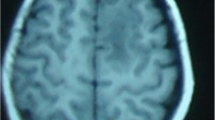Summary
The cerebral lesions in tuberous sclerosis are of three kinds: subependymal nodules, cortical tubers, and cluster of heterotopic cells in the white matter. Understanding of these hamartomas is still incomplete even with modern imaging modalities. Magnetic resonance (MR) images of ten patients with tuberous sclerosis were reviewed and compared to computed tomographic (CT) scans and to the clinical severity of the disease. T2 weighted spin echo (TR=1800, TE=120) images and inversion recovery (TR=2100, TI=500–600, TE=40) images were obtained at the same axial planes. Periventricular nodules were better seen, because of their calcifications, with CT than with MR imaging. They were demonstrated as iso- to low intensity depending on the amount of calcification on T2 weighted images, and as a similar intensity to the white matter on IR images. Small peripheral lesions in the hemispheres, which were only occasionally seen as small low density areas on CT scans, were well demonstrated on MR images. These foci were hyperintense on T2 weighted images, and hypointense on IR images. Exact location of these was not in the cortex, but in the subcortical white matter. The findings indicate that these foci represent the pathologically well known demyelinating foci, which are commonly present under the cortical tuber, but may be independent of them. Cortical tubers were not confidently identified, which suggested that they might have similar intensity to the cortical gray matter. Some of the parenchymal calcifications other than periventricular nodules showed identical MR signal intensities to periventricular nodules, and the rest of the parenchymal calcifications had similar intensities to the subcortical lesions. This indicates that parenchymal calcifications can occur in the demyelinating white matter as well as in the heterotopic tubers in the white matter. The severely mentally retarded patients tended to have a higher number of subcortical lesions and no correlation was noted between the severity of mental retardation and either the number of periventricular nocules or ventricular dilatation.
Similar content being viewed by others
References
Fitz CR, Harwood-Nash DCF, Thompson JR (1974) Neuroradiology of tuberous sclerosis in children. Radiology 110: 635–642
Gomez MR, Mellinger JF, Reese DF (1975) The use of computerized transaxial tomography in the diagnosis of tuberous sclerosis. Mayo Clin Proc 50:553–556
Martin GI, Kaiserman D, Liegler D, Amorosi ED, Nodel H (1976) Computer-assisted cranial tomography in early diagnosis of tuberous sclerosis. JAMA 235:2323–2324
Barry JF, Harwood-Nash DC, Fitz CR, Byrd SE (1977) Uhrecognized atypical tuberous sclerosis diagnosed with CT. Neuroradiology 13:177–180
Lee BCP, Gawler J (1978) Tuberous sclerosis: comparison of computed tomography and conventional neuroradiology. Radiology 127:403–407
Monaghan HP, Krafchi BR, McGregor DC, Fitz CR (1981) Tuberous sclerosis complex in children. Am J Dis Child 135: 912–917
Gardeur D, Palmieri A, Mashaly R (1983) Cranial computed tomography in phakomatoses. Neuroradiology 25:293–304
Kingsley DPE, Kendall BE, Fitz CR (1986) Tuberous sclerosis: a clinico-radiological evaluation of 110 cases with particular reference to atypical presentation. Neuroradiology 28: 38–46
Glass RBJ, Mendelsohn DB, Hertzanu Y (1984) Atypical findings on computed tomography in tuberous sclerosis. S Afr Med J 66:145–146
Pinto-Lord MC, Abroms IF, Smith TW (1986) Hyperdense cerebral lesion in childhood tuberous clerosis: computed tomographic demonstration and neuropathologic analysis. Pediatr Neurol 2:245–248
Garrick R, Gomez MR, Houser OY (1979) Demyelination of the brain in tuberous sclerosis: computed tomography evidence. Mayo Clin Proc 54:685–689
McMurdo SK Jr, Moore SG, Brant-Zawadzki, Berg BO, Koch T, Newton TH, Edward MSB (1987) MR imaging of intracranial tuberous sclerosis. AJNR 8:22–82
Roach ES, Williams DP, Laster DW (1987) Magnetic resonance imaging in tuberous sclerosis. Arch Neurol 44: 301–303
Urich H (1976) Malformations of the nervous system, perinatal damage and related conditions in early life. In: Blackwood W, Corsellis JAN (eds) Greenfields neuropathology. Year Book Medical Publishers, Chicago, pp 410–417
Suzuki C (1952) The practical measurement of intelligence of individual children (Japanese). Tokyo-tosyo, Tokyo
Tsumori M, Inage K (1972) The measurement of intelligence of infants (Japanese). Dainippon-tosyo, Tokyo
Haberland C (1979) Clinical experience at the Mayo Clinic. In: Vinken PJ, Bruyn GW (eds) Handbook of clinical neurology, vol 31. North Holland, Amsterdam, pp 4–10
Dot RF, New PFJ, Pile-Spellman J, Rosen BR, Shoukimas GM, Davis KR (1986) The detection of intracranial calcifications by MR. AJNR 7:801–809
Author information
Authors and Affiliations
Rights and permissions
About this article
Cite this article
Inoue, Y., Nakajima, S., Fukuda, T. et al. Magnetic resonance images of tuberous sclerosis. Neuroradiology 30, 379–384 (1988). https://doi.org/10.1007/BF00404101
Received:
Issue Date:
DOI: https://doi.org/10.1007/BF00404101




